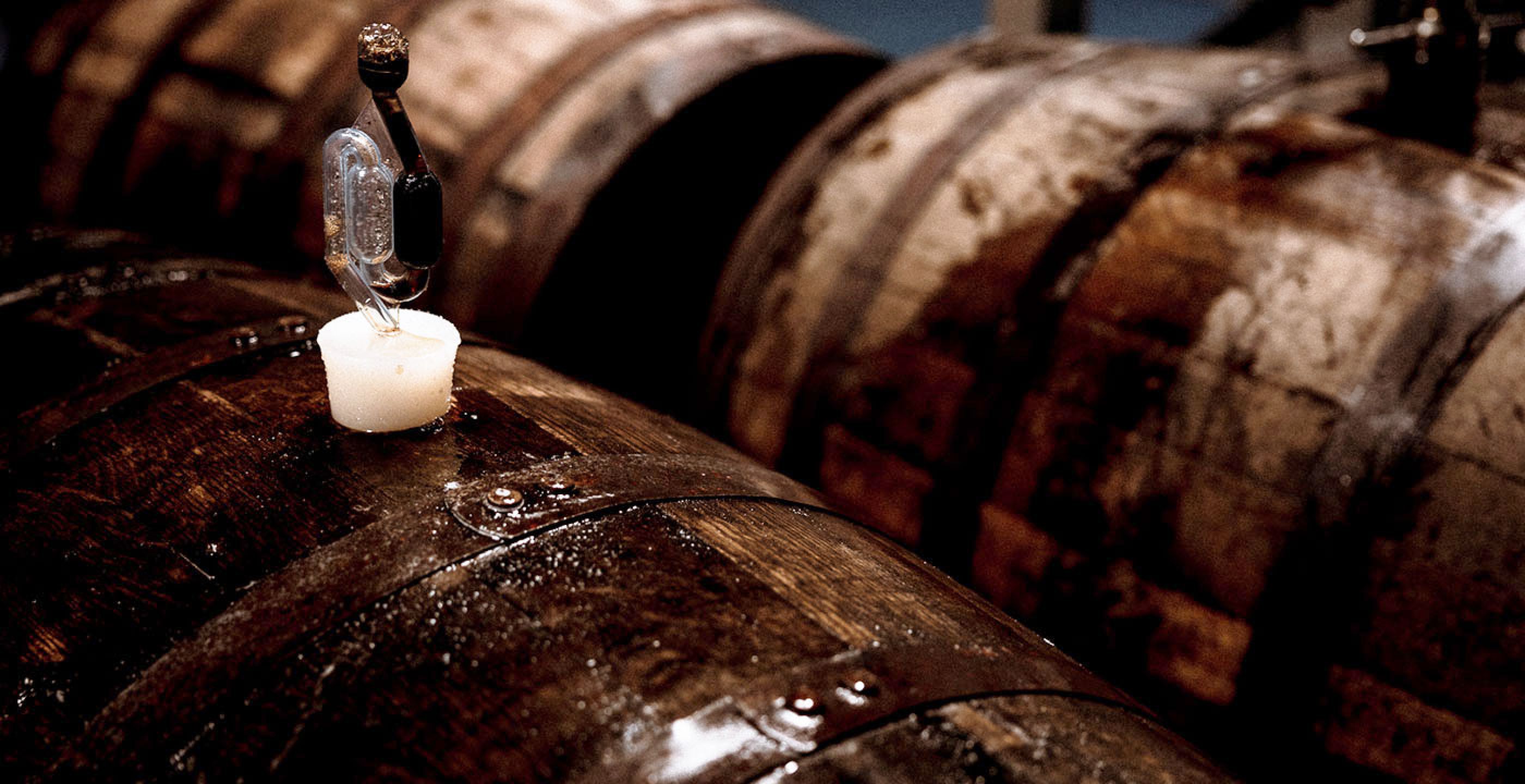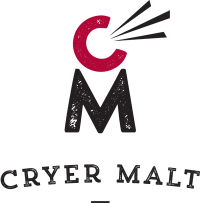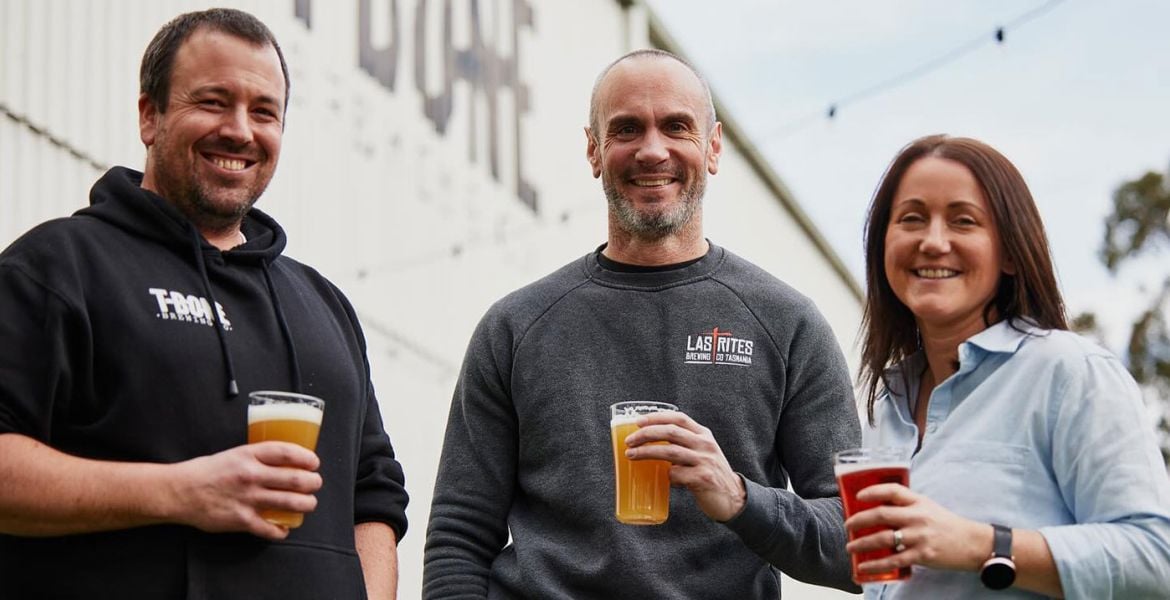Winter is here and, naturally, that means we’ve entered imperial stout season.
Sure, there are those who would argue there’s never a bad time to enjoy such beers but, as the temperature drops, there are plenty of brewers eager to bring them out of hibernation – sometimes literally in the case of those aged in barrels.
One brewery entering the fray in 2024 is Fox Friday – and they're doing so for the first time. Yes, despite the significant impact they've made on the Australian beer scene since the original business was acquired by Benny and Sarah Hooper and taken in a new direction – not to mention the dozens of beers they've released since then – June 28 will represent the first time they've put a barrel-aged beer into drinkers' hands.
However, the brewers at the helm when the twin Who. Are. You. releases hit taps and shelves are far from newcomers; in fact, this is the third barrel program they've worked on together in Australia.
Justin Corbitt and Ned Bowring previously oversaw barrel programs at Hawkers and Deeds, learning plenty of lessons along the way. So I sat down with them and Benny to sample the bourbon barrel-aged duo while finding out what goes into creating such beers, a conversation taking in patience, the search for perfection, and Kentucky hugs.
As for the beers themselves, each has been created from a blend drawn from a mix of Willett, Knob Creek and Jim Beam casks that have been working their magic on the liquids inside them at Fox Friday’s Hobart brewery for 18 months or more.

“We selected ten barrels out of about 45 and picked the ones that we liked the most in terms of what we're looking for flavour-wise,” says head brewer Justin.
Volume 1 is a straight expression of the base beers, bringing plenty of milk and dark chocolate, hints of smoke and plenty of bourbon, whereas Volume 2 features the addition of toasted organic coconut and vanilla beans. They're available in very limited volumes too, solely from Fox Friday's taprooms in Hobart, Melbourne and Perth.
“Adjuncts are a great lever to pull and can really change the face of the beer,” Justin says of their approach.
“You can always make a super adjuncty stout. But I love the subtlety of doing it with bourbon barrel-aged stout and using real raw materials and not flavourings.”
The name references the question asked of Alice by the Hookah-Smoking Caterpillar in Alice In Wonderland and was inspired by the idea of barrels being such a rabbit hole for brewer and drinker alike.
It’s a question the Fox Friday team likes to ask of every beer: who are you and what are we trying to achieve as brewers?
“You’re always trying to find that special liquid,” Benny says of the ongoing journey to create the perfect beer. “And while each beer is special in its own way, you always sit there – whether it’s a hoppy beer, pilsner, stout, bourbon barrel aged imperial stout – you always go ‘This is great, but … we could have done this.'”
Nonetheless, with barrels there’s a whole lot of complexity, time and lessons learned over a long time.
“You are playing with elements you can’t control,” Benny adds.
A Brewer’s Tool Belt

Beginning at the beginning of Justin and Ned's approach: why age imperial stouts in bourbon barrels? Why not use a whisky, rum or wine barrel?
All work, of course, but for Fox Friday’s first foray into barrels, their reasons go beyond Justin’s affinity for the spirit as a native of America’s South. They love what bourbon can do thanks to the vanillin content that comes from the distillers using fresh oak, as well its sweeter nature compared with many other dark spirits.
“In our experience, bourbon is the most natural fit,” Ned says.
When talking about building a barrel program, the brewers frequently turn to the importance of creating a broad stock from which to pick. Thus different types of bourbon barrels with different beers inside them so, as Justin puts it, you ensure you have as many tools in your tool belt as you can have.
“If you’re going to be doing a program and do lots of releases,” he adds, “then you want to have as many levers as you can pull in order to create these different products.
“We've always been strong believers that having different barrels and different recipes is ultimately what allows you to blend and achieve something greater than the sum of its parts.”
While he’s enjoyed great imperial stouts from single barrels, Justin prefers to have a broad palette to draw from when painting a picture for your palate.
“It’s not quite one-dimensional but in a way it is,” he says. “But if you have a lot of different aspects to it, you can slowly but surely build something: ‘Oh we’ve got a bit of dark chocolate here, some raisin here and a bit of this, that, or the other’.”

It's all about building complexity in the final beer through points of difference, whether that’s the barrels themselves, the alcohol content, the malt bill, the bitterness or any other weapon in their arsenal. Ned talks about limiting the roast or going heavier on it for certain recipes, but says the key on brew day is to make a beer with the barrel in mind.
“The best result we have is building beers for barrels,” he says. “Rather than having an imperial stout that you brew, it’s a batch brewed especially for the barrels. So we might have a bigger body that holds up a bit better, especially if the barrels hold a lot of bourbon, which can thin the body out.
“Some of the beers going into barrel might not taste super balanced, they might need a bit of time to round out, particularly if they’re higher ABV.”
Justin says the barrels needn't have contained the fanciest of former inhabitants. Sure, you might get some impressive characters from oak that once housed a whisky worth more than a thousand dollars, but he feels that when you’re looking to create bourbon barrel-aged beer you want it to taste like, well, bourbon.
“My biggest thing is that if you crack open a can, you want to make sure that it’s there,” he says.
“You can get 25-year-old Pappy Van Winkle barrel that’s super subtle and soft, but if you want to have impact on the liquid in a second fill, you want to get that bourbon flavour into it.
“I've always found that barrels that aren’t necessarily super high-end but aren’t the bottom of the barrel – excuse the pun – work.”
Creaky Oak

Securing barrels isn’t straightforward either – and not simply because Kentucky is a long way from Tassie. The price per barrel tends to fluctuate between $400 and $600, with the oak in high demand not just from other brewers across the world but also Scotch whisky makers who rely heavily on the casks as the industry – and arguably drinkers at large – have moved on from sherry.
It's a situation worlds removed from the American South in which Justin was raised.
“When I was growing up in West Virginia and drove down to Kentucky, you’d see bourbon barrels on the side of the street. They’d throw them out and people would take them and burn them.”
Beyond the cost, it’s a complex market in which factors other than demand often move the price.
“The market can be really up and down,” Justin says. “It’s a problem in the US and it comes from everywhere. There was a glass shortage in Kentucky and, if they can’t bottle bourbon, they can't empty the cask. And if they can’t empty the casks, we can’t get any.”
Once the barrels are secured, the hard work is far from over; bourbon barrel-aged beers might be delicious and premium, but the barrels themselves aren’t all that. Making bourbon requiring the barrels to be used just once, so they aren't necessarily built to last.
Ned says: “They leak, they’re notoriously a pain in the arse to deal with when you age beer in them, you need to swell them.
“You can soak them in hot water, or you can steam them; you’ve just got to get the wood to swell.”
Beyond swelling the barrel to help keep the liquid inside, they talk about fighting back against oxidation by purging with CO₂ and filling the barrel slowly, while ensuring the beer is warm and “flat as a tack” to reduce any headspace.
By its very nature, it’s a process that requires a lot of commitment and a steady and clear line of communication between Justin in Melbourne and the brew team in Hobart.
“The barrels are awkward,” Justin says. “They leak, they fail, and you have bad barrels that you have to dump down the drain. They turn, they change over time; it’s not a wild animal but you are trying to tame a beast a little bit.”
Once those barrels are full, the first few months are all about patience; little happens in the first six months in particular.
“There’s generally not much point in [sampling] prior than that, you’re not going to see much action until later on,” Justin says.
“And then you go in with your hammer and your nails and tap a little hole in the bottom and start sampling from there.”
The Kentucky Hug

Checking on the barrels involves regular gravity and pH tests; a sudden drop in the latter suggests an infection and the end of the road for the liquid inside.
Assessing the impact of the bourbon along the way matters too. While bourbon casks don’t tend to make it into the country particularly wet – particularly compared to those containing Australian whisky which might still have plenty of dram's worth of liquid sloshing around – the booze pickup still tends to vary.
“You can get one-and-a-half percent ABV pick up and you’ll sure taste that,” Ned says.
It’s why identical recipes in two otherwise identical Willett barrels can end up tasting quite different, and why they spend a lot of time keeping track and sampling their dozens of barrels.
“You need to taste through individual barrels, you can’t just assume the recipe will come out the same," he says. "They can taste very different.”
For Who. Are. You., the tasting session saw Justin, Benny and fellow Fox and barrel-aged stout enthusiast Alistair Davis go through each barrel in over three days at the Hobart brewery as team members called in to chat liquid too. Like many aspects of the beer industry, it sounds like a lot of fun but it’s also a lot of work.
“It's a labour of love; you need to do it,” Justin says. “You want to do it too, but you sit down and go, ‘I did not want to sip 15 imperial stouts today.’
“And you have to be objective about how they are and what flavours you’re getting, because those notes will ultimately guide your blend.”
Beyond finding out how the liquid tastes, you’re also looking for what might ultimately construct a final beer or beers. Justin talks about thinking through each flavour and seeing how different casks could work when brought together.
“When you’re tasting through the barrels, you’re grading them in a way, and you’re grading them on what you’re pulling from it,” he says.
“One might have heavy bourbon on the nose and, if you’re using ten barrels, do all of them need that? Probably not; maybe four will have that. And then you start looking for characteristics you might see in the other barrels, like smoke, dark fruit or dark chocolate.”

“Sometimes the barrel shows you want it wants to be,” Ned says. “You can’t have preconceived notions in your mind of what it should be.”
It becomes a long process over several days searching for a liquid that says something special while also showing the potential to become part of a different story.
Justin takes up the tale: “Most of the time, you’ll have some cracker barrels but they’ll be cracker in a certain direction in terms of flavours and aromas.
“So you look at those different attributes that stand out and think about what will add another layer of complexity to the blend because, ultimately, most of what you’re looking for in these beers is complexity.”
Having said that, there are exceptions. Or, perhaps, exceptionals...
“I think the only one that falls outside of a blend is when you taste a barrel that's so good that it could be its own release,” Justin says. “That does happen.”
There's the flip-side too, of course.
“Be prepared to put beer down the drain,” Ned says. “You do it for the love and you have to keep the standard because there are barrels that just won’t be right. They don’t have a place other than going down the drain.”

Along the way, to ensure a beer is ready, there’s one thing they’re always looking for: The Kentucky Hug.
Justin first learned about the hug from Brad Clark of Jackie O’s. The Ohio brewery is located just across the border from Justin’s native West Virginia and is highly acclaimed for big stouts, barleywines and use of barrels.
To explain what is meant by The Kentucky Hug, Justin points to the front of his mouth.
“He talked about you would taste it and, if was burning here, it wasn’t ready," he says.
He then points to the back of his throat:
“If it was here, it wasn’t ready.”
He then moves his finger to his chest:
“But if the warmth was here, then he knew the barrel was good to go.”
It’s a warmth that only comes with time and when Justin and Benny were last travelling through the States, it was a refrain that was often repeated.
Another aspect of the sampling process is the need to consider future releases too; Benny talks about how exciting even barrels with relatively fresh beer can be at a given moment.
“There’s a great journey for each barrel,” he says. “There’s some that have taken on some really good characters already and they haven’t had much time, so it’s really exciting to see – with more time, where’s that going to lead us?”
Curiouser & Curiouser

Once empty, the barrels are unlikely to be filled with imperial stout again. Again, this can come down to the quality of the wood but the beer also takes a lot from the oak and won’t soak up as much flavour in the same way again.
“You can use them again, it depends on their state,” Justin says. “But with bourbon barrels, they are a one-time barrel. There are some beautiful barrels out there, like Cognac, but [bourbon barrels] are made cheaply.”
On the occasions they have reused barrels, Ned says they've enjoyed success with other styles: old ales or a barleywines, both of which have featured regularly in the annual release schedule of their barrel-loving alma mater Hawkers.
“You aren’t necessarily looking to put an imperial stout back in there because you won’t get the same characteristics," he says.
Who. Are. You. represents the start for Fox Friday when it comes to making the sort of beers they love drinking. And, while they’ve started with bourbon, there are countless other barrels, from maple to apple brandy, for which they’d like to build recipes.
“I think there’s no limit to what you can do,” Justin says.
But when it comes to barrels, evolution is slow. Even as a program grows, brew days are infrequent and ideas, techniques and palates change over time.
“It takes years to get where you want the program to be,” Ned says. “It’s a long feedback loop so you do need to really care about it because you need to be patient.
“You’ve really got to ride that passion because that’s what it’s all about. It’s so much work, so you’ve got to be focused on the end goal, which is this product we care about so much.”
While they have plenty of experience exploring barrels, they feel they're only just starting to dive down the barrel rabbit hole…
“We want to slowly work out a way to achieving something that’s spectacular and so close to perfection,” Justin says, before Ned jumps in.
“And achieving perfection is not possible," he says. "If you want to make great beer, you just keep striving for better beer. And it’s never-ending.”
Who. Are. You. Volumes 1 and 2 are released on June 28 through Fox Friday's Hobart, Melbourne and Perth taprooms. They're available in very limited quantities.
WIN! If you're a member of The Crafty Pint's beer club, The Crafty Cabal, you could win a mixed four-pack of Who. Are. You. plus a hoodie and limited edition glass. Head here for details of the competition.

























